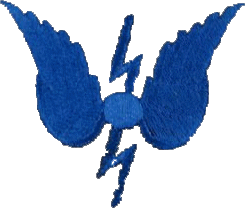|
|
|
|
|
DATE OF DESIGN |
|
1925. |
|
FREQUENCY RANGE |
|
Transceiver - transmitter 150 - 460 kc/s : receiver 65 - 500 kc/s. |
|
POWER SUPPLIES |
|
Supplied from an engine which is part of the Set. |
|
RANGE IN MILES |
|
N/K or N/A |
|
TYPE OF SET |
|
VALVE |
|
WAVEFORM |
|
CW/ICW/RT |
|
METHOD OF PRODUCING OSCILLATIONS |
|
SELF |
|
WHERE USED/FITTED |
|
Portable Equipment. Type 30A is the name used in the Royal Navy for the Army's Portable Set 'C' MkII. It is transported on a Trojan tyred cart. The cart wheels and axle are removable and the cart provide a bench for setting up the receiving station. The receiver is set up at least 20 yards from the engine to prevent interference, thus dividing the station into two parts which are:-
(1) Transmitter with its engine driven generator, transmitting aerial and accessories.
(2) Receiver with its frame aerial and accessories.
The transmitter is remote controlled from the receiving station.
Two tents are supplied to protect the equipment and power unit (not necessarily the men)!
The aerials is very large.
The transmitter emits CW on 150 to 460 kc/s and has a range of 40 miles using one 36 foot aerial; 20 miles with two 15 foot aerials and 3 miles with two 4 foot aerials.
The receiver is cable of reception of CW or ICW-R/T transmissions. For CW the receiver uses *autodyning* to produce the Morse note. The receiver consists of a Tuner, an Amplifier and a Herterodyne. It has three frequency bands 300-500 kc/s, 135-300 kc/s and 65-135 kc/s.
Type 30A is fitted in many Fleet units and takes over from the Type 30.
To propel the set along a road with easy gradients, a minimum of four men is required, but with the set removed from the cart and transported in crates as explained in the Book of Instructions, six men are necessary as a minimum. The total weight complete is 1386lbs; without the car 828lbs; receiver and batteries only, 56lbs.
Autodyne Reception, Self-Heterodyne Reception, are names given to those modes of beat reception in which the auxiliary oscillations are generated within windings and condensers that are essential parts of ordinary receiving circuits |
|
ASSOCIATED WAVEMETER |
|
ARMY MK C< |
|
FURTHER READING |
|
|
|
IMAGES, PHOTOS, DOCUMENTS, SCHEMATICS ETC.(Click images to enlarge) |
|
|
|
NOTES. |
|
Notes on photos:
1 - Two views of same cart - left looking from the back end and right the front end pulling ropes and pulling shaft and handle.
64 = Engine
107 = receiver aerial and aerial mast
108 = wavemeter
110 = transmitter
111 = receiver
112 = tent
113 = tent
114 = equipment like Morse key and earphones etc
115 = equipment like buzzer unit and valves etc
116 = transmitter aerial box
117 = tool box
2 - Transmitter schematic
3 - Transmitter
4 - Army wavemeter
5 - Receiver schematic
6 - Receiver
7 - Transmitter and Receiver schematics as a system
8 - Type 30A Transmitting system
9 - Type 30A Receiving system |


